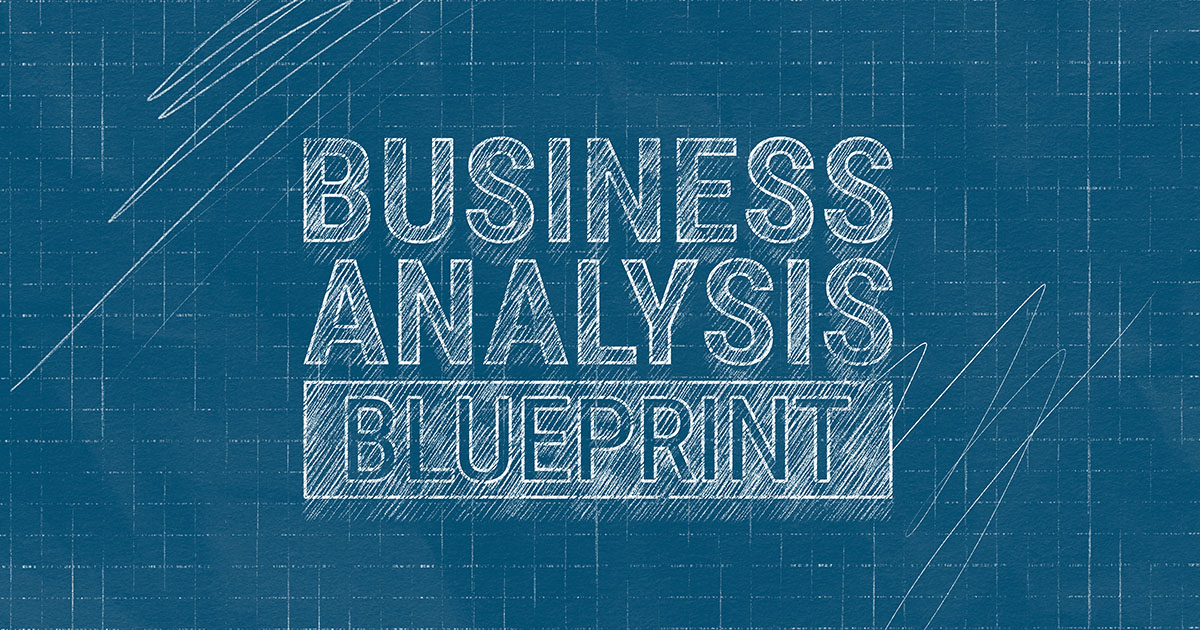Business Analysis Blueprint
Laura Paton

Laura Paton’s career is a masterclass in leadership, innovation, and the transformative power of business analysis. With over 40 years of experience, she not only has witnessed the evolution of the profession but has also been a driving force behind it. From her early days navigating hybrid PM/BA roles to leading the development of the globally recognized BABOK Guide v3, Laura’s influence extends far beyond her own career.
A true trailblazer, Laura’s journey is a testament to the boundless opportunities within business analysis. Whether mentoring aspiring analysts, teaching on platforms like LinkedIn Learning, or championing the profession’s role in a world that’s changing fast, she continues to push the boundaries of what’s possible. Her work with IIBA has shaped the standards, practices, and perceptions of business analysis worldwide, inspiring countless professionals to elevate their craft.
We recently had the privilege of speaking with Laura about her remarkable career, her pivotal role in advancing the business analysis profession, and her advice for the next generation of professionals looking to make their mark.

With over 40 years in the business analysis profession, what stands out as the most memorable and defining moment of your career?
After spending a short time in software development, I wanted to take on more responsibility. This led me to pursue my PMP certification and take on project management positions at a time when most companies utilized PM/BA hybrid roles. The PM/BA role is where I learned I favoured the requirements-related responsibilities more than the project leadership ones.From a professional development and growth perspective, preparing for my PMP was a great experience. So, I began researching whether a professional organization existed for business analysis, akin to the one for project management. Lo and behold, I stumbled upon IIBA, a fledgling nonprofit that was supporting the work of business analysts.
I wrote to IIBA’s senior leadership and was asked to join the BABOK Guide v2 team as a project manager. The connection and experience ultimately paved the way for my role as IIBA’s Head of Product Development, soon followed by the honour of chairing and leading the development of the BABOK Guide v3.
In what ways has your involvement with IIBA influenced your career growth and professional development?
Starting as a volunteer enabled me to network and stay involved in several early IIBA initiatives. I developed invaluable relationships and acquired an immeasurable amount of experience in the professional standards and certification space.Leading the development of one of the most recognized publications on business analysis (the BABOK Guide v3) enabled me to work with business analysis professionals across the globe—not only to build the gold standard in business analysis but also to learn from others about how they use business analysis for strategic advantage and successful projects.
What advice would you offer to aspiring or early-career business analysts looking to thrive in the profession?
Never stop learning and always challenge yourself. My career in business analysis wasn’t a single path—I’ve always been involved in a variety of initiatives. For example, I have:
- Worked in corporate roles across large, mid-sized, and small companies
- Volunteered with IIBA
- Served on the board of my local IIBA chapter
- Taught business analysis at universities and for corporate education providers
- Established business analysis practices for several companies
- Developed business analysis course materials for many clients
- Spoken at business analysis and project management conferences and chapter events
- Delivered webinars
- Started a business analysis podcast
- Worked as a business analysis consultant for both IIBA and PMI
The point is that business analysis is everywhere, but you need to be proactive to discover your path and interests. Take the initiative to create your own opportunities.
Reflecting on your career journey, what do you think were the key skills or traits that helped you transition from software development to business analysis and project management?
The three skills that helped me most in making these transitions were research, problem-solving, and communication. As a developer—at least back in the 1980s—you typically weren’t expected to be inquisitive; you were simply assigned tasks and expected to complete them. What I disliked most about that role was the lack of opportunity to engage directly with customers and understand the "why" behind the work.Fortunately, times have changed. Agile teams now take a much more collaborative approach, but I’m still grateful for having made the career transition. I’ve always enjoyed problem-solving and having the opportunity to engage with a variety of stakeholders to suggest solution ideas based on my research. The ability to learn new parts of the business and new technologies and systems kept me engaged and challenged.
Lastly, I’d add that my strengths in collaboration, communication, organization, and leadership helped make the transition into project management and business analysis a smooth one.
You’ve had the unique experience of contributing to the development of the BABOK Guide, both v2 and v3. What was the most rewarding or challenging aspect of shaping such an influential resource for the business analysis community?
Identifying the single most rewarding aspect of that work is difficult—there were many meaningful and fulfilling experiences.When I joined the v2 team, I was asked to take on the project management responsibilities. Although I held a PMP certification at the time, I was new to the standards development process. This experience allowed me not only to learn how standards are developed but also to work alongside some of the most brilliant minds in the business analysis community—an experience for which I’ll always be grateful.
Version 2 was a multi-year effort, which meant there was ample time to learn and observe how such a significant body of work comes together. By the time IIBA was ready to begin development on v3, I had gained a great deal of experience, both through IIBA and in my professional career. I was honoured to be asked to chair the v3 initiative, a role that came with great responsibility and many challenges.
We set out to ensure v3 would surpass the achievements of v2 by expanding global engagement, especially in terms of practitioner-authored content. We issued a call for core team members and received an overwhelming response. I reviewed countless resumes and conducted many interviews before narrowing the pool down to a final team of 10 core contributors.
Whether it was luck or instinct, I remain deeply proud (and admittedly biased) when I say that the team we assembled exceeded all expectations. They brought incredible experience, skill, and depth of thought to the table—qualities that truly shaped the success of v3. It was a multi-year effort, and over time we grew together as a team, sharing hours of deep, insightful, and often challenging discussions. We received feedback from around the world and adjudicated thousands of suggestions to refine and improve our draft. Eventually, we published the BABOK Guide v3 in 2015.
We must have done something right, because v3 is still going strong today and is widely recognized as a global standard for business analysis.
From a challenges perspective, two things stand out most. First, we had to take hundreds upon hundreds of pages—written by a diverse group of core team authors—and revise them into a cohesive document that read as if it were written in a single voice. That’s no easy task; every contributor has their own unique writing style.
Second, managing such a large group of writers and reviewers—more than 75 people—was an enormous undertaking. I even had a large organizational chart taped to my wall to track the reporting structure we put in place. It helped me stay organized, monitor progress, and, more importantly, maintain personal connections with each team member. I wanted to get to know them beyond just assigning work and checking off tasks.
It was truly a privilege to collaborate with business analysis professionals from across the globe throughout the development process.
As someone who has worked in PM/BA hybrid roles, how do you think the relationship between project management and business analysis has evolved over the years?
When I first started, Waterfall was the only approach to delivery, and the roles of the project manager and business analyst were clearly defined. Then Agile came along, and it threw both roles a curveball.Project managers had to shift from a “command and control” mindset to becoming servant leaders or Scrum Masters. Business analysts went through a rough patch, as some teams questioned whether the role was still even necessary. It was, of course, but it took time for organizations and practitioners to fully understand how project managers and business analysts could work collaboratively on Agile teams without overlapping or stepping on each other’s toes.
At the same time, the discipline of business analysis was evolving. New frameworks, techniques, and tools were emerging, helping to mature and elevate the profession. These advancements played a big role in helping to clarify and delineate the business analysis role within Agile environments. Now that Agile has been around for nearly 25 years, the responsibilities of both roles are much better understood. The introduction of professional standards and certifications has further helped define the roles and provide clarity.
That said, things still aren’t perfect. Some organizations continue to misunderstand these roles and attempt to run projects with only one of the two. When that happens, we often find ourselves having the same conversations—educating project managers about the full scope of responsibilities they’re expected to take on if they’re functioning as both the project manager and business analyst.
Your work with LinkedIn Learning allows you to share your expertise with a global audience. What do you enjoy most about teaching, and how do you approach making business analysis concepts accessible to learners?
I believe business analysis professionals are natural teachers. We're often the bridge between the problem space and the solution space, explaining business needs to designers and developers and then translating solution options back to the business. That kind of role naturally lends itself to sharing knowledge and helping others understand.Throughout my career, I’ve been fortunate to gain a wide range of experiences, and teaching has become a meaningful way for me to pass the baton—to help others start or grow in their careers. I truly enjoy seeing someone progress in their understanding, moving from point A to point B. And I especially love helping learners master the skills they need to prepare for professional certification. There’s nothing more rewarding than having students reach back out after earning their CBAP and including me in their celebrations.
It’s been an amazing journey, from teaching in traditional classroom settings to live virtual training, and now to creating recorded courses on LinkedIn Learning (LIL). The platform has become an amazing resource for professionals who want to build skills on demand, right from their own offices. From an approach perspective, LIL instructors get to work with an incredibly talented team of professionals, including content managers who monitor the community's training needs, producers, and lighting and sound experts. It's truly a whole team of talent that comes together to put out the high-quality content you find on the platform.
Looking back on your time with IIBA, what do you think has been the most significant change or advancement in the business analysis profession since you first got involved?
One of the biggest changes I’ve seen is in IIBA’s brand recognition. When I joined IIBA as Head of Product Development, simply raising awareness was a lot of work. At the time, I would often meet project managers and business analysis professionals who still hadn’t heard of IIBA or the BABOK Guide.
There’s still work to do, but today it’s far less common to have a project manager or business analysis professional who isn’t familiar with IIBA and its role in advancing the profession. A lot of employers now require (or at least recognize) IIBA certifications as part of their hiring and promotion process.
Aside from brand recognition, I think we're all keeping our eyes on AI and how it’s shaping the profession.
You’ve had a career spanning over 40 years, with roles in corporate, nonprofit, and educational settings. How did working across these different environments shape your perspective on business analysis?
I wouldn’t change anything about the industries or positions I’ve worked in. Having the opportunity to work in a variety of settings—across small, medium, and large organizations—was invaluable. It gave me a deeper understanding of the unique business analysis challenges each environment faces, as well as the different approaches they take to the work.
The variety of contexts I exposed myself to over my career definitely helped me broaden and sharpen my skills while experiencing a variety of maturity levels in business analysis practices.
What trends or emerging practices in business analysis do you find most exciting right now, and how do you think they'll shape the future of the profession?
Right now, it’s all about AI—for everyone. I don’t fear it. I’m excited about the opportunities it brings.
AI is already enhancing our ability to conduct research by analyzing large data sets more efficiently. It’s also helping us complete some of the more labour-intensive or routine tasks, like generating meeting minutes from recordings or summarizing lengthy notes. We're able to use AI to create initial drafts of our process maps, identify process bottlenecks, and recommend areas for automation.
As AI takes over repetitive, low-value work, it's allowing business analysis professionals to focus on what truly matters: innovation, strategy, and more human-centric analysis. That shift is incredibly exciting to me because it's helping to elevate our roles.
For someone considering a career in business analysis, what would you say are the biggest misconceptions about the role, and how would you address them?
I believe there are still teams—and even some business analysis professionals—who think the role is solely about gathering and documenting requirements. While requirements are certainly a significant part of what we do, they’re only one aspect of the broader value we bring.
To shift this perception, business analysis professionals need to fully understand the breadth of their responsibilities and actively demonstrate the value they can deliver. This is essential to ensure the role isn’t minimized or underutilized. If you're just starting out in the profession, you need to know the entirety of the role so you don't get relegated to simply handling documentation.
Another common misconception is that one person can effectively handle project management and business analysis. Whether this belief stems from misunderstanding or a desire to reduce costs, it’s an issue that needs to be addressed. While there are rare cases where a PM/BA hybrid role can work, I often see business analysis being short-changed—or poorly executed—when the roles are combined.
If you want a career in business analysis, look for a position that values business analysis work. Don’t get trapped into taking a project management role where you’re also responsible for requirements work.
Lastly, I would say that business analysis is a passion. While companies may try to assign a myriad of employees to the role, true business analysis professionals thrive in uncertainty. They love learning and researching. They're strong facilitators, problem solvers, and change enablers.
If you’re looking for a position with a high degree of certainty and a clear, linear path to delivery, business analysis may not be the right fit. Business analysis often operates in ambiguity, where the problem isn't fully defined, the stakeholders may have competing needs, and the path forward requires exploration, facilitation, and critical thinking.
It’s a role for those who are comfortable navigating complexity and uncovering clarity where none exists.
In 2025 and beyond, we’re spotlighting the versatility, value, and far-reaching impact of talented business analysis professionals like Laura through Analysis Everywhere. If you need some inspiration for sharing your own story, visit our website for more information.
Know someone who's making an impact as a business analysis professional? Reach out to brand@iiba.org to have them featured in our next Business Analysis Blueprint.
About the Author

Robert McClements is the Communications and Media Relations Specialist at IIBA. With over eight years of communications experience at non-governmental organizations, he contributes to IIBA’s marketing and communications efforts in support of the business analysis profession and community. Residing in his hometown of Montreal, Robert enjoys spending time with his family, listening to music, and reading.


